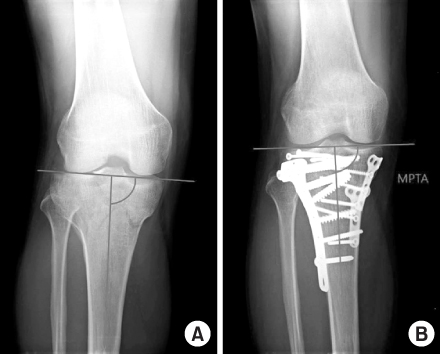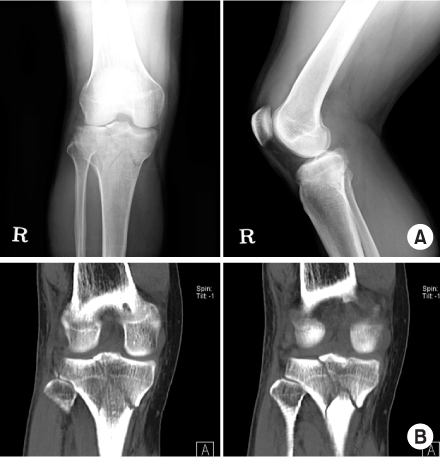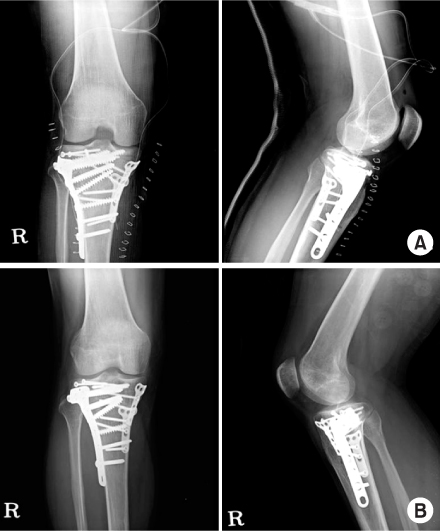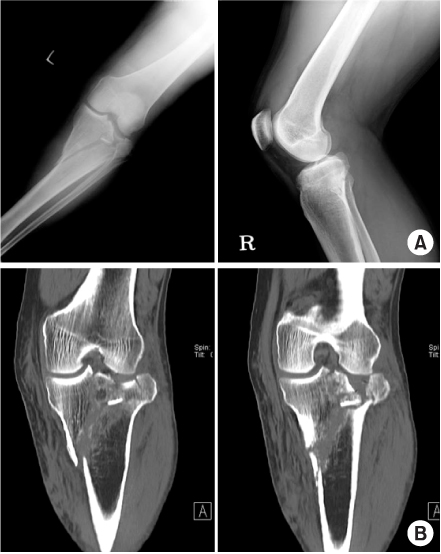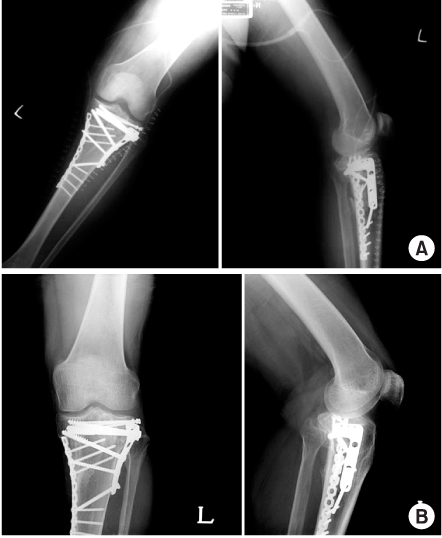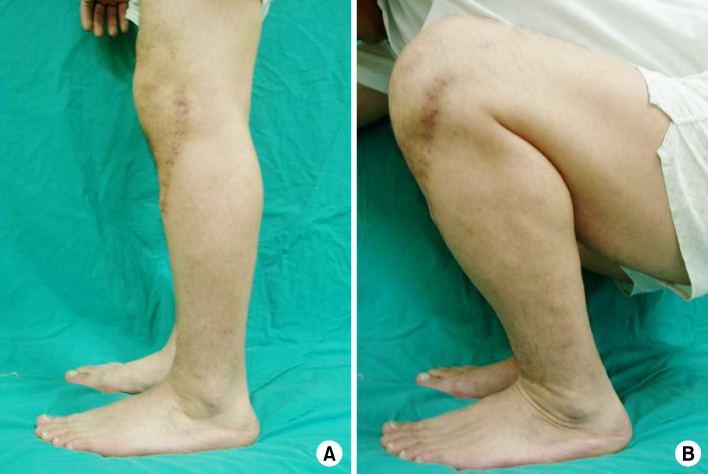J Korean Fract Soc.
2009 Oct;22(4):252-258. 10.12671/jkfs.2009.22.4.252.
Treatment of Shatzker Type VI Tibia Plateau Fracture Using Lateral and Posteromedial Dual Incision Approach and Dual Plating
- Affiliations
-
- 1Department of Orthopaedic Surgery, Korea University Anam Hospital, Seoul, Korea. oshan@korea.ac.kr
- KMID: 1469991
- DOI: http://doi.org/10.12671/jkfs.2009.22.4.252
Abstract
- PURPOSE
To evaluate the radiologic and clinical results of treatment of the Shatzker type 6 tibia plateau fracture using the lateral and posteromedial dual incision approach and dual plating. MATERIALS AND METHODS: Twelve cases in eleven patients of Shatzker type 6 tibia plateau fracture which has been treated using the lateral and posteromedial dual incision approach and dual plating were analyzed with an average follow-up of 16 months. Times to union, alignment and reduction loss on radiograph and postoperative clinical outcome with checking the range of motion of the knee joint, Knee Society Score and UCLA activity scale were analyzed and evaluated. RESULTS: In all cases, bony union was obtained in an average fifteen weeks after the operation, and there was no reduction loss. The arc of motion of the knee joint at the latest follow-up was 132 degrees on average. Average of Knee Society Score was 85 and UCLA activity scale was decreased from 9.6 points preoperatively to 5.7 points postoperatively. CONCLUSION: The treatment of Shatzker type 6 tibia plateau fracture using the lateral and posteromedial dual approach and dual plating have shown clinically preferable results of excellent recovery of joint motion and good knee society score by early range of motion exercise after firm fixation. However, it was high energy injury, so the sports activity of patients was significantly decreased.
Figure
Cited by 2 articles
-
Current Concepts in Management of Tibia Plateau Fracture
Sang Hak Lee, Kang-Il Kim
J Korean Fract Soc. 2014;27(3):245-260. doi: 10.12671/jkfs.2014.27.3.245.Medial Minimally Invasive Percutaneous Plate Osteosynthesis in Proximal Tibial Comminuted Fractures
Jae-Ang Sim, Kwang-Hui Kim, Yong-Seuk Lee, Sang-Jin Lee, Beom-Koo Lee
J Korean Orthop Assoc. 2014;49(4):278-284. doi: 10.4055/jkoa.2014.49.4.278.
Reference
-
1. Barei DP, Nork SE, Mills WJ, Coles CP, Henley MB, Benirschke SK. Functional outcomes of severe bicondylar tibial plateau fractures treated with dual incisions and medial and lateral plates. J Bone Joint Surg Am. 2006; 88:1713–1721.
Article2. Cho SK, Oh JD, Lee YS, Choi JT, Lim GR. Surgical treatment of tibia plateau fracture. J Korean Soc Fract. 1997; 10:832–842.3. DeCoster TA, Nepola JV, el-Khoury GY. Cast brace treatment of proximal tibia fractures. A ten-year follow-up study. Clin Orthop Relat Res. 1988; 231:196–204.4. Georgiadis GM. Combined anterior and posterior approaches for complex tibial plateau fractures. J Bone Joint Surg Br. 1994; 76:285–289.
Article5. Gösling T, Schandelmaier P, Marti A, Hufner T, Partenheimer A, Krettek C. Less invasive stabilization of complex tibial plateau fractures: a biomechanical evaluation of a unilateral locked screw plate and double plating. J Orthop Trauma. 2004; 18:546–551.6. Horwitz DS, Bachus KN, Craig MA, Peters CL. A biomechanical analysis of internal fixation of complex tibial plateau fractures. J Orthop Trauma. 1999; 13:545–549.
Article7. Insall JN, Dorr LD, Scott RD, Scott WN. Rationale of the Knee Society clinical rating system. Clin Orthop Relat Res. 1989; 248:13–14.
Article8. Jiang R, Luo CF, Wang MC, Yang TY, Zeng BF. A comparative study of Less Invasive Stabilization System (LISS) fixation and two-incision double plating for the treatment of bicondylar tibial plateau fractures. Knee. 2008; 15:139–143.
Article9. Lachiewicz PF, Funcik T. Factors influencing the results of open reduction and internal fixation of tibial plateau fractures. Clin Orthop Relat Res. 1990; 259:210–215.
Article10. Lavernia CJ, Sierra RJ, Hungerford DS, Krackow K. Activity level and wear in total knee arthroplasty: a study of autopsy retrieved specimens. J Arthroplasty. 2001; 16:446–453.11. Moore TM, Patzakis MJ, Harvey JP. Tibial plateau fractures: definition, demographics, treatment rationale, and long-term results of closed traction management or operative reduction. J Orthop Trauma. 1987; 1:97–119.12. Park HG, Yoo MJ, Kim MH, Byun WS, Chun JY. Treatment of tibial plateau fractures using Ilizarov fixation (Schatzker type IV, V, VI). J Korean Fract Soc. 2004; 17:230–236.
Article13. Rasmussen PS. Tibial condylar fractures. Impairment of knee joint stability as an indication for surgical treatment. J Bone Joint Surg Am. 1973; 55:1331–1350.14. Stevens DG, Beharry R, McKee MD, Waddell JP, Schemitsch EH. The long-term functional outcome of operatively treated tibial plateau fractures. J Orthop Trauma. 2001; 15:312–320.
Article15. Waddell JP, Johnston DW, Neidre A. Fractures of the tibial plateau: a review of ninety-five patients and comparison of treatment methods. J Trauma. 1981; 21:376–381.
Article16. Watson JT. High-energy fractures of the tibial plateau. Orthop Clin North Am. 1994; 25:723–752.
Article17. Young MJ, Barrack RL. Complications of internal fixation of tibial plateau fractures. Orthop Rev. 1994; 23:149–154.
- Full Text Links
- Actions
-
Cited
- CITED
-
- Close
- Share
- Similar articles
-
- Treatment of Schatzker Type V and VI Tibial Plateau Fractures Using a Midline Longitudinal Incision and Dual Plating
- Lateral Locked Plating or Dual Plating: A Comparison of Two Methods in Simple Bicondylar Tibial Plateau Fractures
- Dual Plate Fixation Compared with Hybrid External Fixator Application for Complex Tibial Plateau Fractures
- Meniscal Incision to Approach for Lateral Tibial Plateau Fractures
- Staged Treatment of Bicondylar Tibial Plateau Fracture (Schatzker Type V or VI) Using Temporary External Fixator: Correlation between Clinical and Radiological Outcomes


